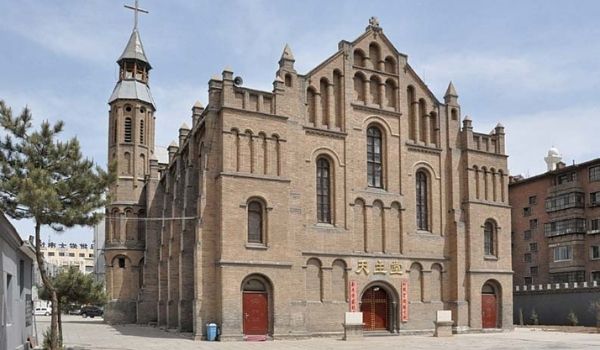
In a land area of approximately 17,224 square kilometers, the diocesan territory covers the prefecture-level cities of Hohhot and its administrative area that includes 4 districts (Huimin, Xincheng, Yuquan and Saihan), 4 counties (Togtoh, Wuchuan, Horinger and Qingshuihe) and the county-level Tumed Left Banner.
According to the 2010 Census, the population of Hohhot reached 2,866,615. The majority of Hohhot people are Han Chinese, representing 87.16 percent of the total population. Most of them are descendants of people from Shanxi who have settled in the area over the past several decades, or those who have migrated from northeastern China and Hebei province after the founding of the People's Republic of China in 1949, supported by government initiatives at the time to promote the development of border regions.
There are 36 minority ethnic groups inhabiting in Hohhot, including Mongolian, Hui, Manchu, Korean, Daur and Oroqen. A significant portion of the population is of mixed ethnic origin.
Having been integrated into mainstream urban society, most Mongolians in the city speak fluent Mandarin Chinese in addition to Mongolian. However, younger speakers are moving towards speaking Mandarin amongst themselves as well. Jin (Hohhot) dialects are in use as well in the diocesan territory.
Catholicism was introduced to Mongolia in the 1830s. The Holy See entrusted the extensive area to the Congregation of the Immaculate Heart of Mary (popularly called Scheut Fathers) in 1864. The Vicariate Apostolic of Southwestern Mongolia was erected in 1883 and renamed to Suiyuan in 1922. When the Chinese Church Hierarchy was erected in 1946, Suiyuan was elevated to an archdiocese, which headed other six dioceses in the ecclesiastical prefecture.
According to the Pontifical Yearbook, there were 41.932 Catholics among 1,065,775 people in 29 parishes, served by 69 priests and 34 religious women.
Religious activities were disrupted for three decades due to political turmoil since the 1950s. All foreign missioners were expelled from the mainland. In early 1980s, when the Church gradually revived, the government-sanctioned "open" community restructured the ecclesiastical territories to form five dioceses in Inner Mongolia in accordance with civil administrative boundaries. Suiyuan was cancelled and most of its area became Hohhot diocese, which is based in the regional capital.
Hohhot lies on the Jingbao Railway from Beijing to Baotou, and is served by two railway stations: Hohhot Station and Hohhot East Station. Trains to Beijing link to destinations to the south and the northeast. The most prominent rail link with Beijing is the overnight K90 train, which has served the Hohhot-Beijing line since the 1980s.
Westbound trains go through Baotou and Lanzhou. There are also rail links to most major Inner Mongolian cities and to Ulaanbaatar. Because the quickest trip from Beijing takes around eight and a half hours despite the close distance of the cities, plans for high-speed rail has been discussed for years, but construction has been consistently postponed.
Hohhot's Baita International Airport is about half an hour from the city center by car. It has direct flights to Beijing, Shanghai, Shenzhen, Chengdu, Wuhan, Hong Kong etc., and to Ulaanbaatar, Mongolia. Long distance buses connect Hohhot to outlying counties, the cities of Baotou, Wuhai, Ordos, and other areas in Inner Mongolia.
Hohhot lies at an average of 1,050 meters above sea-level in the middle temperate in-land regions. The city features a cold semi-arid climate, marked by long, cold and very dry winters, hot, somewhat humid summers, and strong winds, especially in spring. The coldest month is January, with a daily mean of -11.6 °C, while the July, the hottest month, averages 22.6 °C. The annual mean temperature is 6.73 °C, and the annual precipitation is approximately 400 millimeters, with more than half of it falling in July and August alone. Hohhot is a popular destination for tourists during the summer months because of the nearby Zhaohe grasslands. More recently, due to desertification, the city sees sandstorms on almost an annual basis.
Hohhot has over 40 kinds of minerals with rich deposits including coal, oil, copper, iron, zinc and gold in its urban and adjacent areas. Fertile land and rich produce offer a unique advantage for the development of farming and animal husbandry.
As an important industrial city in Inner Mongolia, Hohhot is developing along the path of modernizing its industrial structure and diversifying its economy. The five major industries are dairy, electric power, electronic information biological and drug preparation, and metallurgical and chemical industries.
Hohhot is the capital of the Inner Mongolian Autonomous Region, located in Tumochuan Plain, the central part of Inner Mongolia. The name of the city in Mongolian means " Green City." Hohhot is encircled in "Golden Triangle," which has rich sources in the autonomous region, by the Yinshan Mountains to the north, and the Yellow River to the south with grassland, water resources and rich soil.
Due to its relatively diverse cultural make-up, and despite its characteristics as a mid-sized Chinese industrial city, the Hohhot street scene has no shortage of ethnic minority elements. Tongdao Road, a major street in the old town area, is decorated with Islamic and Mongol exterior designs on all its buildings. A series of government initiatives in recent years have emphasized Hohhot's identity with ethnic minority groups, especially in increasing Mongolian-themed architecture around the city. All street signs as well as public transportation announcements are regulated to be in both Chinese and Mongolian.
Food specialty in the area is mostly focused on Mongolian cuisine and dairy products. Commercially, Hohhot is known for being the base of nationally renowned dairy giants Yili and Mengniu. The Mongolian drink suutei tsai ("milk tea" in English) has become a typical breakfast selection for anyone living or visiting the city. The city also has rich traditions in the making of hot pot and shaomai (a traditional Chinese dumpling). There is also a large selection of Korean and Muslim restaurants, in addition to cuisine from other regions of China.